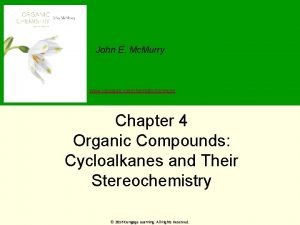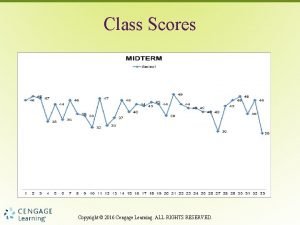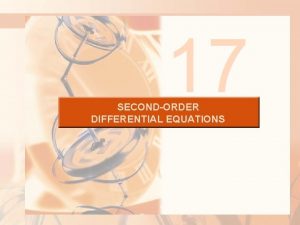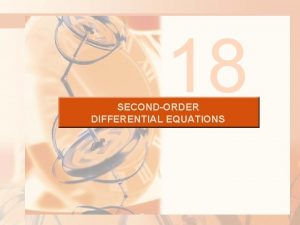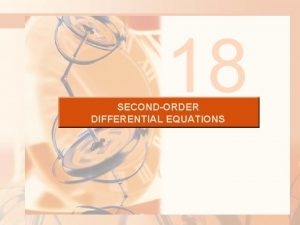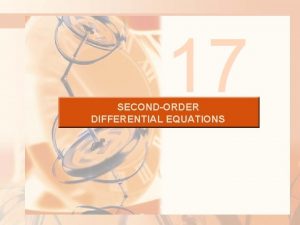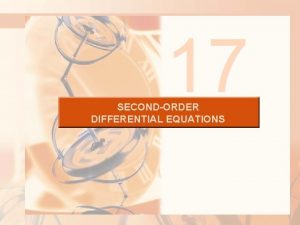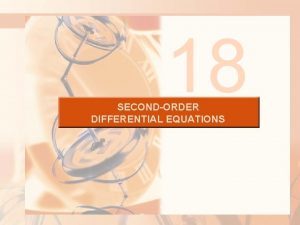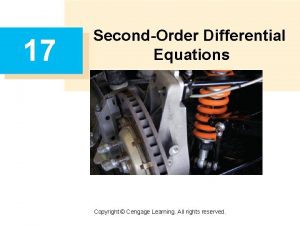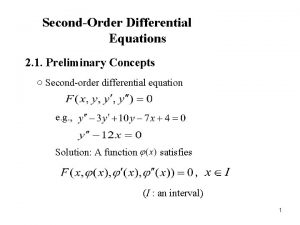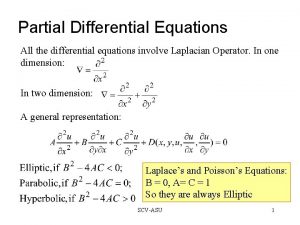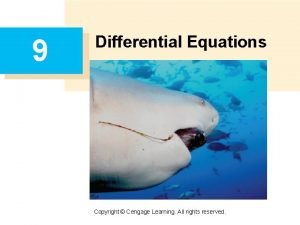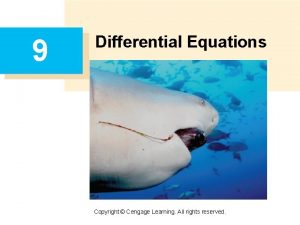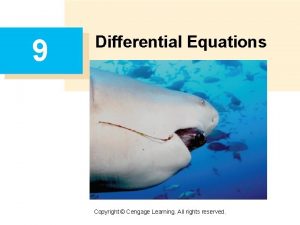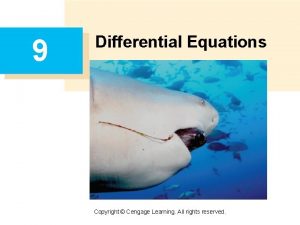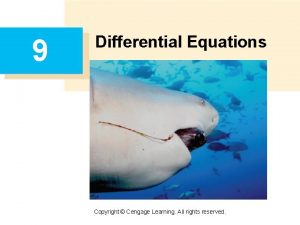17 SecondOrder Differential Equations Copyright Cengage Learning All































- Slides: 31

17 Second-Order Differential Equations Copyright © Cengage Learning. All rights reserved.

17. 1 Second-Order Linear Equations Copyright © Cengage Learning. All rights reserved.

Second-Order Linear Equations A second-order linear differential equation has the form where P, Q, R, and G are continuous functions. In this section we study the case where G(x) = 0, for all x, in Equation 1. Such equations are called homogeneous linear equations. 3

Second-Order Linear Equations Thus the form of a second-order linear homogeneous differential equation is If G(x) 0 for some x, Equation 1 is nonhomogeneous. 4

Second-Order Linear Equations Two basic facts enable us to solve homogeneous linear equations. The first of these says that if we know two solutions y 1 and y 2 of such an equation, then the linear combination y = c 1 y 1 + c 2 y 2 is also a solution. 5

Second-Order Linear Equations The other fact we need is given by the following theorem, which is proved in more advanced courses. It says that the general solution is a linear combination of two linearly independent solutions y 1 and y 2. This means that neither y 1 nor y 2 is a constant multiple of the other. For instance, the functions f (x) = x 2 and g(x) = 5 x 2 are linearly dependent, but f (x) = ex and g(x) = xex are linearly independent. 6

Second-Order Linear Equations Theorem 4 is very useful because it says that if we know two particular linearly independent solutions, then we know every solution. In general, it’s not easy to discover particular solutions to a second-order linear equation. 7

Second-Order Linear Equations But it is always possible to do so if the coefficient functions P, Q, and R are constant functions, that is, if the differential equation has the form where a, b, and c are constants and a 0. It’s not hard to think of some likely candidates for particular solutions of Equation 5 if we state the equation verbally. 8

Second-Order Linear Equations We are looking for a function y such that a constant times its second derivative y plus another constant times y plus a third constant times y is equal to 0. We know that the exponential function y = er x (where r is a constant) has the property that its derivative is a constant multiple of itself: y = rerx. Furthermore, y = r 2 er x. If we substitute these expressions into Equation 5, we see that y = er x is a solution if ar 2 er x + brer x + cer x = 0 or (ar 2 + br + c)er x = 0 9

Second-Order Linear Equations But erx is never 0. Thus y = erx is a solution of Equation 5 if r is a root of the equation Equation 6 is called the auxiliary equation (or characteristic equation) of the differential equation ay + by + cy = 0. Notice that it is an algebraic equation that is obtained from the differential equation by replacing y by r 2, y by r, and y by 1. 10

Second-Order Linear Equations Sometimes the roots r 1 and r 2 of the auxiliary equation can be found by factoring. In other cases they are found by using the quadratic formula: We distinguish three cases according to the sign of the discriminant b 2 – 4 ac. 11

Second-Order Linear Equations Case I: b 2 – 4 ac > 0 In this case the roots r 1 and r 2 of the auxiliary equation are real and distinct, so y 1 = and y 2 = are two linearly independent solutions of Equation 5. (Note that is not a constant multiple of. ) Therefore, by Theorem 4, we have the following fact. 12

Example 1 Solve the equation y + y – 6 y = 0. Solution: The auxiliary equation is r 2 + r – 6 = (r – 2)(r + 3) = 0 whose roots are r = 2, – 3. Therefore, by , the general solution of the given differential equation is y = c 1 e 2 x + c 2 e– 3 x 13

Example 1 – Solution cont’d We could verify that this is indeed a solution by differentiating and substituting into the differential equation. 14

Second-Order Linear Equations Case II: b 2 – 4 ac = 0 In this case r 1 = r 2; that is, the roots of the auxiliary equation are real and equal. Let’s denote by r the common value of r 1 and r 2. Then, from Equations 7, we have so 2 ar + b = 0 We know that y 1 = er x is one solution of Equation 5. We now verify that y 2 = xer x is also a solution: = a(2 rer x + r 2 xer x) + b(er x + rxer x) + cxer x = (2 ar + b)er x + (ar 2 + br + c)xer x 15

Second-Order Linear Equations = 0(er x) + 0(xer x) = 0 The first term is 0 by Equations 9; the second term is 0 because r is a root of the auxiliary equation. Since y 1 = er x and y 2 = xer x are linearly independent solutions, Theorem 4 provides us with the general solution. 16

Example 3 Solve the equation 4 y + 12 y + 9 y = 0. Solution: The auxiliary equation is 4 r 2 + 12 r + 9 = 0 can be factored as (2 r + 3)2 = 0 so the only root is r = By , the general solution is y = c 1 e– 3 x/2 + c 2 xe– 3 x/2 17

Second-Order Linear Equations Case III: b 2 – 4 ac < 0 In this case the roots r 1 and r 2 of the auxiliary equation are complex numbers. We can write r 1 = + i r 2 = – i Where and are real numbers. [In fact, = –b/(2 a), = ] Then, using Euler’s equation ei = cos + i sin 18

Second-Order Linear Equations We write the solution of the differential equation as y = C 1 + C 2 = C 1 e( +i )x + C 2 e( – i )x = C 1 e x(cos x + i sin x) + C 2 e x(cos x – i sin x) = e x[(C 1 + C 2) cos x + i(C 1 – C 2) sin x] = e x(c 1 cos x + c 2 sin x) Where c 1 = C 1 + C 2, c 2 = i(C 1 – C 2). 19

Second-Order Linear Equations This gives all solutions (real or complex) of the differential equation. The solutions are real when the constants c 1 and c 2 are real. We summarize the discussion as follows. 20

Example 4 Solve the equation y – 6 y + 13 y = 0. Solution: The auxiliary equation is r 2 – 6 r + 13 = 0. By the quadratic formula, the roots are 21

Example 4 – Solution By cont’d , the general solution of the differential equation is y = e 3 x(c 1 cos 2 x + c 2 sin 2 x) 22

Initial-Value and Boundary-Value Problems 23

Initial-Value and Boundary-Value Problems An initial-value problem for the second-order Equation 1 or 2 consists of finding a solution y of the differential equation that also satisfies initial conditions of the form y(x 0) = y 0 y (x 0) = y 1 Where y 0 and y 1 are given constants. If P, Q, R, and G are continuous on an interval and P(x) 0 there, then a theorem found in more advanced books guarantees the existence and uniqueness of a solution to this initial-value problem. Examples 5 illustrate the technique for solving such a problem. 24

Example 5 Solve the initial-value problem y + y – 6 y = 0 y(0) = 1 y (0) = 0 Solution: From Example 1 we know that the general solution of the differential equation is y (x) = c 1 e 2 x + c 2 e– 3 x Differentiating this solution, we get y (x) = 2 c 1 e 2 x – 3 c 2 e– 3 x 25

Example 5 – Solution cont’d To satisfy the initial conditions we require that y (0) = c 1 + c 2 = 1 y (0) = 2 c 1 – 3 c 2 = 0 From c 1 + we have c 2 = c 1 and so c 1 = 1 c 1 = gives c 2 = 26

Example 5 – Solution cont’d Thus the required solution of the initial-value problem is y = e 2 x + e– 3 x 27

Initial-Value and Boundary-Value Problems A boundary-value problem for Equation 1 or 2 consists of finding a solution y of the differential equation that also satisfies boundary conditions of the form y (x 0) = y 0 y (x 1) = y 1 In contrast with the situation for initial-value problems, a boundary-value problem does not always have a solution. The method is illustrated in Example 7. 28

Example 7 Solve the boundary-value problem y + 2 y + y = 0 y (0) = 1 y (1) = 3 Solution: The auxiliary equation is r 2 + 2 r + 1 = 0 or (r + 1)2 = 0 whose only root is r = – 1. Therefore the general solution is y (x) = c 1 e–x + c 2 xe–x 29

Example 7 – Solution cont’d The boundary conditions are satisfied if y (0) = c 1 = 1 y (1) = c 1 e– 1 + c 2 e– 1 = 3 The first condition gives c 1 = 1, so the secondition becomes e– 1 + c 2 e– 1 = 3 30

Example 7 – Solution cont’d Solving this equation for c 2 by first multiplying through by e, we get 1 + c 2 = 3 e so c 2 = 3 e – 1 Thus the solution of the boundary-value problem is y = e–x + (3 e – 1)xe–x 31
 Cengage differential equations
Cengage differential equations Separation of variables differential equations
Separation of variables differential equations Copyright cengage learning. powered by cognero
Copyright cengage learning. powered by cognero Delmar cengage learning medical terminology
Delmar cengage learning medical terminology Cengage chapter 5
Cengage chapter 5 Cengage learning heart diagram
Cengage learning heart diagram South-western cengage learning
South-western cengage learning 2009 delmar cengage learning
2009 delmar cengage learning 2009 delmar cengage learning
2009 delmar cengage learning Cengage learning heart diagram
Cengage learning heart diagram Delmar learning medical abbreviations
Delmar learning medical abbreviations Cengage learning australia
Cengage learning australia Graphing tpr
Graphing tpr Whille
Whille Cengage learning
Cengage learning Wadsworth cengage learning
Wadsworth cengage learning Cengage learning
Cengage learning Cengage learning plant cell
Cengage learning plant cell Cengage learning
Cengage learning Cengage learning
Cengage learning Brooks cole cengage learning
Brooks cole cengage learning Chapter 7:10 respitory system
Chapter 7:10 respitory system 2014 cengage learning accounting answers
2014 cengage learning accounting answers Cengage learning
Cengage learning Cengage learning
Cengage learning 2009 delmar cengage learning
2009 delmar cengage learning Cengage learning
Cengage learning Chapter 10 cultural diversity
Chapter 10 cultural diversity Consumer behavior cengage
Consumer behavior cengage 2012 cengage learning
2012 cengage learning Training evaluation
Training evaluation Cengage learning psychology
Cengage learning psychology























